|
present Book Reviews For Amateur & Avocational Archaeologists |
 |
|
present Book Reviews For Amateur & Avocational Archaeologists |
 |
General Anthropology Textbooks, Essays, Journals & Publications
|
||||||||||||||||||||||||||||||||||||
| Home | Gallery | Latest Finds | Back to Main Book Review Index |
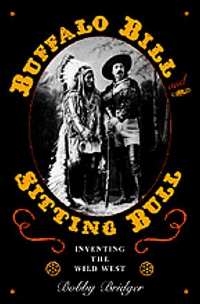
|
Buffalo Bill &
Sitting Bull: Inventing the Wild West by Bobby Bridger University of Texas Press 2002 1st ed. ISBN# 0-292-70917-X cloth hardback Bridger, having spent over 40 years researching and writing about the history of the American West in elegant and articulate metered language, has been called the "Shakespeare of the American West." Lauded about by the likes of pundits diverse as Marlon Brando, Vine DeLoria and Dale Wasserman, it was not much of a surprise to see this delightful book, decidedly prose, come from this fine historian and poet. And what a book it is! Reading like a novel, yet filled with annotations and historical data, Buffalo Bill & Sitting Bull does what no other book I've ever read about these two historical figures ever manages to do: It puts these great men into a modern frame, makes us see how daring they were as modern men in an evolving modern American society; how they reinvented themselves over-and-over to not only survive, but thrive in a changing age, indeed they created modern personna types that inundate our society today. He makes these men people of our time. With so much in print about both of these men, it is amazing that Bridger is able to come up with a different take on them. "As the frontier closed and his role in "winning the West" passed into legend, Buffalo Bill found himself becoming the symbol of the destruction of the buffalo and the American Indian. Deeply dismayed, he spent the rest of his life working to save the remaining buffalo and to preserve Plains Indian culture through his Wild West shows." The enigmatic Sitting Bull is shown here to be so much more of a wise leader than previously characterized in other books. His complex relationship with Buffalo Bill and white culture is remarkable in the way Bridger presents it--- we get to see this holy man and leader in a whole new light. I read nearly the entire book in one sitting. Page after page flows by with an undertone-heartbeat that only a poet can invoke in prose. If you do not know this writer, you must investigate him further--- check out his website and the Ballad of the West trilogy. Absolutely top-drawer. Why is Bridger not manically famous? BUY THIS BOOK, you'll love it! Order this book directly from
the University
of Texas Press by clicking here.
It retails for $34.95, but is presently available for $23.42 online.
reviewed
by
Bob
Wishoff
|

|
"We Are Still Here"
American Indians in the Twentieth Century by Peter Iverson Harlan Davidson, Inc. 1998 3rd ed. ISBN# 0-88295-940-9 paperback Covering over 100 years of Native American history beginning with the incident at Wounded Knee in 1890 because in the author's words, "Until recently, for most students of American Indian history, wounded Knee sounded the death knell of Native life within the United States... and Indians as identifiable peoples appeared destined for disappearance." But as Iverson points out, the Indians are still here. "There are many more American Indians in 1997 than there were in 1897." He believes that to non-Indians, modern Native Americans who drive cars and engage in modern life are somehow viewed as "less-Indian" than their forebears, and that historical periods of adjustment by Indians have been too often perceived in entirely negative terms by students of Native American history. Broken into six chapters, we are exposed to all of the facts regarding Native Americans through the years--- their fights for freedom, identity, cultural heritage and more, within and outside of their own communities are succinctly summarized to bring into focus a living, vibrant history of a group of people who are very flexible indeed. In this book, you hear the voices of those whites who mistakenly documented the Indians of their time with the idea that their way would perish--- they were wrong. You also hear voices like Wilma Mankiller, of the Cherokee Nation, who observes that, "the past 500 years had brought utter devastation among our people. But as we approach the 21st century, we are very hopeful... despite everything we survive... Five hundred years from now, a person like herself would proclaim the continuation of Native languages and ceremonies." This author is quite an authority on the topic, having
written many
books on Native America, including co-editing Indians in
American
History, "We Are Still Here" is a textbook. Great reading, and a must for any teacher seeking to create a well-rounded picture of Indians in modern America. While most books focus on the American government actions toward Indians, this book focuses on Indian decisions made in Indian country, by Indians. "We Are Still Here"can
be ordered directly from the publisher, who offers it when ordered
online,
for the discounted price of $12.76. reviewed
by
Bob
Wishoff
|
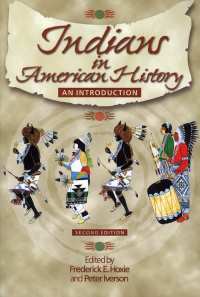
|
Indians in American
History by Frederick E. Hoxie and Peter Iverson, editors Harlan Davidson, Inc. 1998 2nd ed. ISBN# 0-88295-939-5 paperback Comprising fourteen essays by noted authors, this textbook is designed to provide the Indian side to all of the usual Eurocentric historical debate associated with Indians--- familiar topics from a point of view seldom read by students of Native America. I insert the Table of Contents here, because it tells it all: Introduction, Indian/White Relations: A View from the Other
Side
of the "Frontier," by Alfonso Ortiz The breadth of authors listed here is tremendous, and the essays are all guaranteed to motivate a lot of discussion in any classroom, or group of interested individuals. To me, Chapter 8, "How the West was Lost" was the most interesting as I've never read this story from a purely Native American point of view. Fascinating! This is an outstanding and thought-provoking book! Order directly from the publisher, who offers it when ordered online, for the discounted price of $15.96. Click here to order. reviewed
by
Bob
Wishoff
|
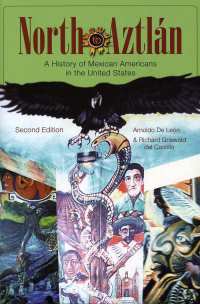
|
North to
Aztlán: A History of Mexican Americans in the United States by Arnoldo De León and Richard Griswold del Castillo Harlan Davidson, Inc. 2006 2nd ed./3rd printing ISBN# 0-88295-243-9 paperback "Mexican people and their culture have been continuously present in the territory for the past four hundred years, and Mexican Americans were actors in United States history long before the national media began to focus on them—even long before an international border existed between the United States and Mexico." Here we have a most interesting book filled with articulate and readable essays about this relevant topic. There's lots you do not know about the history of Mexican Americans! While conceived as a textbook, there's not one person I know who would not benefit from reading this book. With the news filled with sometimes negatinve and sometimes false information about the history of Mexican immigrants, this book seeks to enlighten and inform the reader with focused intent and loads of data. Did you know, for instance, that as much as 10% of the population of Mexico came to the United States to live during the 1930's? "Drs. De León and Griswold del Castillo provide a holistic vision of the development of Mexican American society, one that attributes great importance to immigration (before and after 1900) and the ongoing influence of new arrivals on the evolving identity of Mexican Americans." Read this book and you will better understand the important contributions Mexican Americans have made to the culture of the United States. North to Aztlán retails
for $26.95, but can be bought for $21.56 by ordering it direct
from
the publishers by clicking here.
reviewed
by
Bob
Wishoff
|

|
Farewell, My Nation
by Phillip Weeks Harlan Davidson Inc. 2001 2nd ed. ISBN# 0-88295-956-5 paperback Kent State University history professor Phillip Weeks draws his title from a quote from a Sac and Fox warrior, Black Hawk. "That was the last sun that shone on Black Hawk. His heart is dead, and no longer beats quick in his bosom. He is a prisoner of the white men; they will do with him as they wish…Farewell, my nation!" He characterizes this imprisonment by three policies progressively enforced by an expanding United States seeking ever more land, yet increasingly unwilling to accommodate the native population of these lands. It is simultaneously a story of failed attempts by this native population to accommodate these intrusions while retaining their previous ways of life. Three sequential policy approaches –Separation, Concentration and Americanization- to dealing with “Indian question” are explored as developing over the course of the nineteenth century. The first policy, Separation, came into play up through the 1830s, forcing the Indians out of the trans-Appalachian and northwestern United States. Two schools thoughts emerged regarding this separation; the Gradualists, who “advocated peaceful coexistence… until a steady assimilation of Indians into the dominant society occurred through missionary work, education and reordering Indian land usage,” and the Removalists, who felt the Indians were “incapable of being civilized, were doomed to extinction, and therefore any attempt to civilize them must prove futile.” The Removalists prevailed, “uprooting and removing, often by force, more than 50,000 Indians beyond the Mississippi River. The Indian removal yielded approximately 100 million acres in the eastern United States, for which Indians received 32 million acres.” As Americans gained more territory in the west, as well as their sense of Manifest Destiny and the trails need to implement it’s drive, “the rationale for the policy of Separation and the reasons for establishing and maintaining an Indian sanctuary on the Western prairies, which sounded so immutable in 1840, were crumbling fast as the decade wore on…Federal officials confidently maintained that the policy of Concentration was the solution to the Indian question.” The Indian Territories, established to facilitate the policy of Separation, would soon be reduced to further this policy of Concentration. The Civil War brought not only destruction to the Indian Territory but a further loss of territory. Though Indian forces fought on both sides, the Five Civilized Tribes earlier separated from America on the Indian Territories sided with the Confederacy or remained neutral. The Federal government charged them with violation of their treaties, and their territories further divided with other tribes, furthering the policy of concentration. Sherman also brought the concept of Total War from the Deep South to the West as he fought to further Concentration policies to finally bring the Indians onto reservations during the Plains Wars, with “the olive branch in once hand and the sword in the other.” The governmental control of Indian affairs wavered back and forth between the military and the Interior but the ultimate aim was the same, a policy of Americanization. As described by President Hayes, “…the policy should be to place the Indians as rapidly as possible on the same footing with the other permanent inhabitants of our country.” Fortunately the “other permanent inhabitants” did not have to undergo the same indignities this entailed before the last battle of the nineteenth century at Wounded Knee, to say nothing of the twentieth century battle there. Weeks has provided a comprehensive and well crafted overview of the radical alterations in policy encountered by both cultures during this fateful century, which led to the destruction of so many small nations the wake of a much larger one’s growth. It is accompanied by four excellent maps, photos, and a “bibliographic essay” which is a quite readable guide to better understanding the vast and growing literature available on this pivotal century in Indian history. Farewell, My Nation can
be ordered directly from the publisher, who offers it when ordered
online,
for the discounted price of $12.96. reviewed
by
Charles
Swenson
|
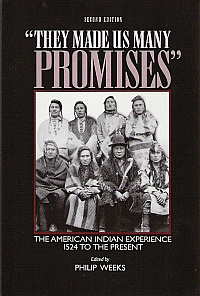
|
"They Made Us Many
Promises" by Phillip Weeks Harlan Davidson Inc. 2002 (Revised ed. of The American Indian Experience, c.1988) ISBN # 0-88295-965-4 A complete coverage of the American Indian experience, which spans half a millennium and the better part of a continent, would seem to be beyond the scope of a book of this size. Yet, Phillip Weeks has presented a deeply satisfying overview in 16 chapters by specialists, well versed in their subject. Each author then presents a list of suggested readings for anyone interested in investigating their specific topic in greater depth, an important bibliographic key to exploring not only the classic literature on the subject but the more recent offerings as well. The first section, A World Turned Upside Down, deals with the transition from an Indian dominated America to Indian domination by Americans. The first chapter deals with early encounters with the English and French in the Northeast, the second with the drawing of indigenous populations into the wars between the French and British empires for dominance over these lands. The uneasy coexistence between the Spanish empire in the Southwest and the occasionally more powerful native peoples there is explored in chapter three, the unsettling expulsion of the Southern Indians by a newly powerful United States in fourth chapter. The editor of this volume adds his insights on the “blue, gray and red” in a chapter on the Civil War as it shaped Indian affairs during the conflict, while this sections final chapter offers it’s understanding of the often ambiguous policies and actions of the Army in clearing the great plains and forcing the Indians into a reservation life. Visions of a New Order in dealing with confinement of the Indians onto reservations and the subsequent refinement of these visions are elaborated on in the next six chapters Part II of this volume. Chapter 7 focuses on the “bitter years” of early reservation life, the next two on the attempts to Americanize the subjugated natives by private and religious reformers and by means of “the educational assault on American Indians” by on- and off-reservation compulsory schooling of their young. The final three chapters in this section take a look at the changing face of federal policy of dealing with the Indian population, from Commissioner of Indian Affairs John Collier’s struggles for a more enlightened “Indian New Deal” to a mid-century trend to termination of “unique legal rights of Indian people and their properties, despite the fact that the Constitution recognized the legal status of the tribes” and trends towards relocation off reservations, and finally the evolution of current Indian policy over the past forty years to their current status. Four chapters comprise the final part, The Night is Far Gone, the Day is Near. One deals with the assimilation of Indian populations into contemporary urban environments, another with the evolution of women’s roles in the Indian communities wrought by the cultural changes over the past 500 years of coexistence with the white men. Native Sovereignty is an overview of the native populations of California and the Northwest from prehistoric to historic and modern times. The last chapter should be of interest to all avocational archeologists – Our Dead are Never Forgotten: American Indian Struggles for Burial Rights and Protection. Written by James Riding In, a citizen of the Pawnee Nation, it is clear in pointing out the sensitive issues that arise regarding the sanctity of untold millions of Native burial sites in the United States. While subtitles within the article such as The Bonding of Colonialism, Scientific Racism, and Imperial Archaeology and Indian Challenges to Imperial Archaeology and Religious Oppression make it clear where Riding In stands on many of the issues, it is also clear that he has done an excellent job of researching his subject matter and the efforts being made towards a mutual respect between America’s Native dead and the archaeological community. For any individual involved in digging the grave responsibilities that arise with regard when stumbling upon a mortuary site must be taken into consideration, as well as the legal ramifications of the Native American Graves Protection and Repatriation Act, should always be taken into consideration. Although “They Made Us Many Promises” is of sufficient depth to be of value to college students, it is also a very pleasurable read. The level of research that comes from the academic background of the authors is satisfying but never overwhelming, and the scope of their presentation is wide enough that each chapter gains from the presence of the others. As with their Farewell, My Nation, also reviewed here, once again Harlan Davidson, Inc has proven that history texts can be vibrant and lively, worthy of reading in their own right while still instilling a deeper understanding of our place in the flow of time. "They Made Us Many Promises"can
be ordered directly from the publisher, who offers it when ordered
online,
for the discounted price of $16.76. Click
here to order. reviewed
by
Charles
Swenson
|
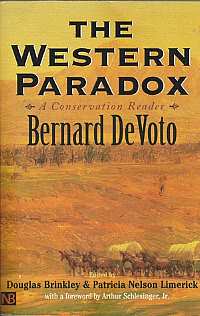 n 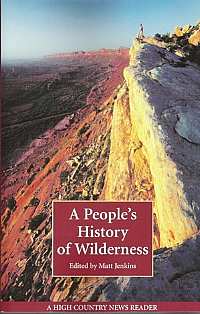
|
The Western Paradox:
A Conservation
Reader by Bernard DeVoto Edited by Douglas Brinkley & Patricia Nelson Limerick Yale University Press 2000 1st edition ISBN# 0-300-08423-4 paperback A People’s History of
Wilderness The wilderness did not die out completely with the pushing out of the native American Indian tribes, nor with the conquest of the Wild West at the end of the 19th century. Vast expanses of the existing wilderness belong to you and me, under the care of the federal Bureau of Land Management. It is an unparalleled natural resource that is also of tremendous archaeological value, an open museum of the history that preceded written history. It is, as Bernard DeVoto expressed it, our “unregarded inheritance from the frontier,” and it is every bit as much at risk now as when it was first wrested from its indigenous inhabitants. Bernard DeVoto was a Pulitzer-prize winning historian best known for his works on Lewis and Clark, as well as other explorers of the West in the first century of the American Republic. From 1934 to 1954 he also published a series of lengthy essays in Harper’s Magazine bemoaning the mismanagement of public lands by private interests and the poor record of conservation of this common inheritance by the BLM in the early part of the 20th century. His stance on many of the issues can be garnered from article titles such as The West: A Plundered Province, Sacred Cows and Public Lands, Statesmen on the Lam, The Sturdy Corporte Homesteader and Conservation:Down and on the Way Out. His influential Easy Chair columns in Harper’s were thought to have help turn elections against more than one legislators, led an Oregon senator to describe him as “the most illustrious conservationist who has lived in modern times” and led the Secretary of Interior to appoint him to the Advisory Board for National Parks, Historical Sites, Buildings and Monuments in 1948. Ten of these articles have been republished in The Western Paradox, which also contains DeVoto’s unfinished 289 page hauntingly beautiful meditation on the West as he experienced it in his travels there. Fifty years after his death it still rings true in describing an American West caught between being a rich natural heritage of barely tapped wilderness and a growing source of exploitation for its natural riches, a delicate balancing act that all too often goes on against a political backdrop not easily understood by the casual observer. Fortunately there were many other conservation activists who understood the importance of preserving the dwindling wilderness areas in the United States. Thanks to the untiring efforts of activists and Forest Service professionals such as Bob Marshall, Aldo Leopold and Arthur Carhart the Wilderness Act of 1964 brought statutory protection to almost 5.5 million acres of wilderness. The relationship between establishment of wilderness areas and the role of the BLM in their protection has not always been easy, and since 1970 such conservation issues have been covered in depth by High Country News. Unfortunately they have not been able to report on any new wilderness areas being added to the system since 1994, and private interests (particularly oil and gas developers) have continued to erode the progress made in previous generations. It is the same battle on the same battlegrounds, political and geographical, that DeVoto fought in the struggle for conservation of an ever disappearing wilderness. A People’s History of Wilderness is a collection of over 70 articles published in High Country News over the past third of a century covering the struggle to preserve our wilderness areas. It is eye opening in its coverage of the degree to which it has been preserved, the struggle on behalf of engaged individuals and government officials to safeguard it. Once pristine wilderness is gone it disappears forever, an ongoing risk that is both well documented and very current in this presentation. Together with DeVoto’s work it presents a broad overview of what stands at stake in the fight for our American wilderness and how we too can work for its protection. The Western Paradox can be ordered directly from the publisher for $18.95, by clicking here. A People’s History of Wilderness
can
be ordered directly from the publisher for $22.95, by clicking here.
reviewed
by
Charles
Swenson
|
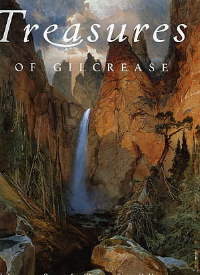
|
Treasures of
Gilcrease: Selections from the Permanent Collection by Sarah Erwin, Anne Morand, Kevin Smith, Daniel C. Swan University Of Oklahoma Press 2005 ISBN# 0-8061-9956-3 oversize paperback The Gilcrease Museum, in Tulsa Oklahoma, boasts of having the largest collection of Western Art in the world and this magnificently illustrated, oversized paperback volume couldn't possibly show everything housed there. And, oh, what is housed there: Over 10,000 paintings and over 100,000 manuscripts, books, photographs and broadsides! The museum exhibits "a Native American painting collection that tells the story of Native painting from hides to ledger books to the Flatstyle of the 20th century" and "anthropological treasures spanning from Clovis spear points 17,000 years old to modern Peyote ritual objects." The authors did a great job, skimming the cream of the collection into a logical and informative volume. The collection is well photographed and appears with succinct, interestingly written commentary. The contents give the viewer a nicely rounded picture of the West through history. I particularly enjoyed the selections from the Library Collection. Again, the items were well photographed, and the oversized page format made the illustrations especially fine to peruse. This book would make a great gift for anyone who appreciates Western and Native arts. (Even better would be a trip to the museum!) A classic coffee-table book, it measures 13.5" x 9.57", and was printed in Hong Kong on heavyweight slick paper. In my opinion, priced as a bargain at only $19.95. Treasures of Gilcrease can
be ordered direct from the publisher, by clicking here.
reviewed
by
Bob
Wishoff
|
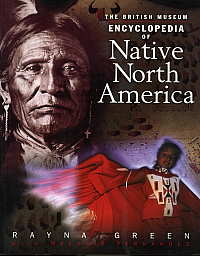
|
The British Museum
Encyclopedia
of Native North America by Rayna Green Indiana University Press 1999 ISBN # 0-253-21339-8 oversized paperback First published by British Museum Press, this nicely illustrated volume is surprisingly different from many encyclopedias on American Indians. Although there is a great deal of historic material here, the focus is clearly contemporary and from the Native American viewpoint. This creates some interesting anomalies, such as an entry on the impact of World War II on American Indians and their contributions to the war effort that is longer than the Wounded Knee entry following it: under gambling there are photos of an Osage stick game, a needlepoint bingo bag and beaded card dauber, and the largest Indian casino (the Pequot Nation’s) in Connecticut. Information on most of the First Nations can be found, though with an emphasis on the more northerly peoples. Modern art receives as much attention as the handicrafts of previous centuries, and literature and music are not neglected. The evolution of contemporary American Indian life patterns and issues can be traced by referencing the alphabetical entries, but I found it much more enlightening to wander randomly through it for insight into how Native American cultures see themselves in relationship to today’s world. There are many surprises to be found here. This visually appealing, oversized paperback edition is a
visual
delight to peruse, and is amazingly comprehensive in its scope, drawing
fully on the backgrounds of the authors: Rayna Green directs the
American
Indian Program at the Smithsonian Institution’s National Museum of
America
History, and Melanie Fernandez is Acting First Nations Officer at the
Ontario
Arts Council. The British Museum
Encyclopedia
of Native North America is available directly from Indiana
University
Press, for the reduced price of $11.00, by clicking here.
reviewed
by
Charles
Swenson
|
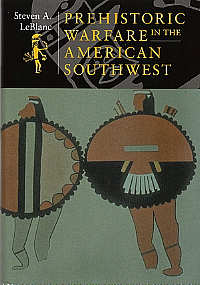
|
Prehistoric Warfare in the American Southwest by Steven A. LeBlanc University of Utah Press 1999 ISBN # 0-87480-581-3 paperback Armed conflict is a cultural constant but relatively little archaeological research has focused on the nature of such conflicts. Studies of the Southwestern Pueblo cultures often speculate on the disappearance of the Anasazi as a result of warfare imposed on them by outside forces, with an increasing amount of research revealing evidence of such warfare. Steven LeBlanc, Harvard archaeologist and Director of Collections at the Peabody Museum of Archaeology and Ethnology, has written extensively on this subject and in Prehistoric Warfare in the American Southwest presents a cogent overview of archaeological evidence of warfare in the Early, Middle and Late Pueblo periods. Leblanc is quick to dismiss the concept of “the noble savage” that he sees as overshadowing much of the work on prehistoric Indian culture. In his introduction he also looks at classic prehistoric causes of warfare, including vengeance, ritual, and most specifically the scarcity of resources. A decreased carrying capacity model incorporates the ecological changes which undoubtedly stressed survival margins and heightened armed competition for available resources. These theories are presented against the backdrop of Southwestern history and changing environmental factors exacerbated by climatic changes. His presentation of the archaeological evidence of warfare offers some interesting concepts of architectural considerations such as defensibility and intervisibilty, as well as burnt sites and evidence of trauma in skeletal remains; it also takes into consideration early historic and ethnographic accounts. The evolution of technology for waging war is traced through the growing sophistication of weapons artifacts themselves but through portrayals of their usage in rock art, kiva murals and pottery design. For Basketmaker and Pueblo I sites (up till 900-950 A.D.) he finds “evidence for typical hunter-gatherer carrying-capacity-constrained warfare” at endemic levels predominating. Environmental changes in form of climatic warming and a wider variety of habitable sites in the Pueblo II and early Pueblo III periods (900-1150 A.D.) resulted in a decreased competition for resources; archaeological findings indicate a corresponding relative decrease in hostilities and increase in more harmonious intercultural interactions. Deteriorating climatic conditions in the mid-1200s again stressed resource availability, increased conflict and necessitated increased defensibility in the late Pueblo III and Pueblo IV periods, bringing about “its most enduring legacy…the movement of people into large, compact communities termed ‘pueblos’ by the Spaniards.” This intensity of warfare precipitated abandonment of marginally sustainable sites, population relocations into larger communities of greater societal complexity, with alliances and trade becoming important alternatives to warfare. A 29 page appendix describes in greater detail some thirty examples of this in the late Pueblo period. Although LeBlanc’s subject matter is the Southwest, his approach has broader implications. “(W)arfare can be recognized and studied in the archaeological record; it is neither insignificant nor tangential to other aspects of society…a driving force behind much cultural behavior.” While his application of this approach opens many windows into an understanding of the role conflict played in prehistoric Puebloean development, there is also an underlying sense that there are valuable lessons to be learned there for contemporary civilization as well. As he clearly states at the end of this book, we cannot afford to “wish away the unpleasant aspects of the human condition if we are ever to understand that condition.” This significant contribution to understanding an all too
often neglected
aspect of Southwestern prehistory is written in a style that is
enjoyable
as a casual read while exhibiting an academic robustness as well.
Hardcover and with over 400 pages and 70 illustrations and maps, Prehistoric
Warfare in the American Southwest can be ordered from
the University of Utah Press, for $45.00 by clicking here.
reviewed
by
Charles
Swenson
|
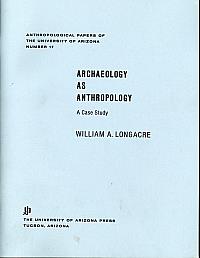
|
Archaeology As Anthropology A Case Study By William A. Longacre University of Arizona Press 1986 5th printing ISBN# 0-8165-0219-6 paperback First published in 1970, this classic paper is an early example of the processual era, or New Archaeology, which many believe split archaeology and anthropology apart. Ironically, Longacre desired that “This monograph may be viewed as a contribution in the continuing debate over the possibility that archaeology, as an integral part of anthropology, can advance general anthropological theory.” What Longacre attempts to do in this study is to prove, from the spatial distribution of potsherd decorative styles within a settlement, whether women resided with their families or their husband's families after marriage (among other things). This is an extraordinary claim and one that received much criticism and scorn. Julie Francis writes, in an essay from “Discovering North American Rock Art,” “I believe this had a profound but very subtle effect… It made us all the more leery of ethnography and of trying to examine the social and ideological aspects of human behavior in the archaeological record.” Whatever you might think of Longacre’s methods and conclusions, this is an ambitious paper and worth a read. A topic very much still alive: In 2001 Longacre gave a Distinguished Lecture at the annual meeting of The Archeology Division of the American Anthropological Association entitled “Archaeology as Anthropology Revisited.” Archaeology as Anthropology is
available
direct from the publisher for $12.95 by clicking here. reviewed
by
Bob
Wishoff
|
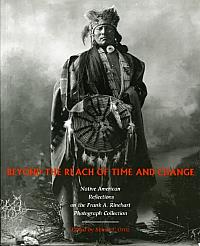
|
Beyond The Reach of
Time and
Change: Native American Reflections on the Frank A. Rinehart Photograph Collection Edited by Simon J. Ortiz University of Arizona Press 2005 1st ed. ISBN# 0-8165-2360-6 oversize paperback Volume 53 of “Sun Tracks: An American Indian Literary Series,” Beyond the Reach of Time and Change is a stunning book and the hurried or casual reader might easily be so seduced by the extraordinary quality of the photographs that they miss the entire point of the volume. The photographs, all taken between June and October in 1898 are from a delegation of over 545 Indians who were invited to the Trans-Mississippi & International Exposition held in Omaha, Nebraska. Shot by Frank Rinehart, the Expo’s official photographer, the photographs command great power, but this book is not about the photographs themselves. As Bobbi Rahder, archivist/curator for the Haskell Cultural Center and Museum at Haskell Indian University, writes in her introduction to the book: “This is not another coffee table book with historical pictures of American Indian leaders. This book is a conversation between the people photographed over one hundred years ago and American Indian people today.” That Native culture is alive today is definitely clear here, but there is more to this, a larger continuity. The Native perspective presented here is one in which the past itself is still very much alive and present today. Tangible are the spirits of each and every “present” moment as seen in each and every photograph of the once and ever renewed “now.” Every essay points this out, this reunion which takes place as each writer sees the always felt spirit of their ever present ancestors. Debra Earling, an enrolled member of the Confederated Salish and Kootenai Tribes of the Flathead Reservation, writes: “All of these Indians--- their life’s breath is still hovering cloudlike in the brief heat of our gaze.” Wonderful insightful writing. Don’t think there’s only one facet to this insight. Ted Jojola, a member of Isleta Pueblo, writes of side show mentalities, and asks “Were these photographs from Hell?” This is an interesting, well-written
and profound
book you’ll want to read. You
can
link to directly to the
publisher's
list of the entire “Sun Tracks: An American Indian Literary Series by
clicking
here.
Beyond
The Reach of Time and Change can be
ordered
direct for $24.95 by clicking here.
reviewed
by Bob
Wishoff
|
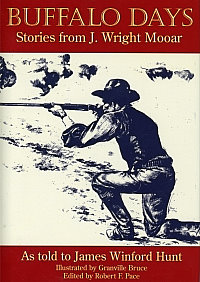
|
Buffalo Days As told to James Winford Hunt State House Press 2005 reprint ISBN# 1-880510-95-2 hardback “The buffalo threw up his shaggy head and looked at the hunter who, crouching on the prairie seven hundred yards away, immediately froze into immobility. The seconds passed. Man and beast regarded each other intently…” So begins Chapter One, entitled “The Chronicle of a Buffalo Hunter, J. Wright Mooar.” Born in Vermont, by 1870, the then nineteen year old Mooar had moved to Kansas where he worked at Fort Hays. He soon met a merchant who was looking for buffalo hides to fulfill an overseas order. After killing 57 more buffalo on his hunt than the merchant needed, Mooar began his full-time career as a hunter, killing, he claimed, more than twenty thousand buffalo before retiring to a life of ranching in West Texas where he lived until his death in 1940. The section entitled “When a Man Was a Man” begins” “Thus for seven days I wandered on, living on a straight diet of buffalo meat.” Here we have stories of Indian fights, lots of hunting, Bat Masterson and Billy the Kid, all told as first-person accounts. But what Mooar really describes, is how in a mere 10 years, the buffalo hunters created a huge business trade and eradicated the buffalo, thus making it possible for white settlers to move into Indian lands. Thus, whether you like the book or not will depend, perhaps, on the point of view you bring to its reading, and it's definitely worth the read! Buffalo Days can
be ordered direct from the publisher for $19.95 by clicking here.
reviewed
by
Bob
Wishoff
|
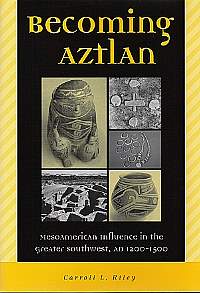
|
Becoming Aztlan:
Mesoamerican Influence in the Greater Southwest, AD 1200-1500 by Carroll A Riley University of Utah Press 2005 ISBN # 0-87480-828-6 cloth hardback Aztlan was the mythological homeland of the Aztecs at the time of the Spanish conquest of Mesoamerica which eventually spawned Coronado’s search for Cibola and the Seven Cities of Gold. Though the conquistadors viewed the area as primarily despoblados, barren wastelands void of habitation, longstanding and well established trade routes into villages of northwestern Mexico and the American Southwest had existed for centuries. These exchanged not only goods such as turquoise, shells, feathers, hides, cotton, flint, salt and pottery but brought a significant Mesoamerican influence on social and religious institutions as well. Carroll Riley brings to bear over 50 years of experience as archaeologist specializing in the Southwest to explain how “…beginning about AD 1200 in the Casa Grandes area and AD 1300…in the upper portion of the area, the late prehistoric Southwest was indeed becoming Aztlan.” After presenting an overview of the cultural and natural backdrop of the area of the American Southwest and northwestern Mexico he frames as Aztlan, he traces the rise of prehistoric Hohokam, Mogollon and Anasazi cultures. Following their eventual collapse in the face of growing drought, colder weather and increasing hostilities resulting from increased competition for decreasing resources, the San Juan Basin was abandoned by AD 1300, and “…for a while, a choice bit of southwestern property, close to a major river, was without human population". Riley sees the resulting migration of the native populations and growing Mesoamerican influence as coinciding with the rise of the Hopi, Zuni and Pueblo cultures in the Southwest, statelets on the Sonoran coast and large villages like Paquime in the Casa Grandes region of Mexico. Paquime covered 88 acres and had a population of thousands, with sophisticated architecture more similar to central Mexico than the Southwest, including buildings over six stories high with whitewashed walls, colonnades, courtyards, canals, cisterns, primitive water and sewer systems. Social structures changed with the rise of cacique-like war leaders also responsible for relationships with other communities. Riley also views increasingly political conditions of war, fortified or easily defended village locations and shifting modes of conflict as likely indications “that the Mesoamerican concept of warfare affected the Southwest…but it probably did not in itself precipitate chronic warfare in the area.” The rise of the kachina cult, though unclear in meanings, may be associated with an infiltration of Mesoamerican religious traditions such as the rain god Tlaloc and his female aspect Chalchihuitlicue, who would have been much in demand in the drier climate, and many included examples of Southwestern rock art seem to represent Tlaloc. An increased rise in kiva and kachina astronomical associations are found with the rise of Aztlan, and it is significant that Mesoamerican and Southwestern constellation groupings are almost identical. Correlations between directional color symbolisms are also seen as strong indications of a common source. And as throughout Riley’s book, examples of pottery and ceramic type distributions are also heavily relied on as indications of cultural crosspollination. Language considerations are investigated with a necessary heavy reliance on early Spanish writings, which themselves were usually part of the Catholic clergy’s attempt at assimilating native populations. These lexicons vary in quality depending on whether Franciscans or Jesuits were doing the recording. The spread of the Uto-Aztecan protolanguage used throughout the region of Aztlan is usually seen as spreading north to south from the western United States, but this does not rule out the possibility of it following agricultural based groups from the south to the north during periods of more hospitable climate and returning with harsher conditions. The final chapter looks the Spanish entradas as they moved out of central Mexico into the world of Aztlan. Though they did not spend as much attention to similarities in the cultures as they did on their futile search for similar riches, there is a wealth of information mined here on the final days of Aztlan as the borderland between the prehistoric and historic southwest. Riley brings together information from many ethnographic
and archaeological
sources to present a clear picture of that often unclear era between
the
disappearance of the Anasazi and the Southwest the Spanish found,
nicely
balanced with material on areas of northwestern Mexican that are all
too
often neglected. It leaves one with a sense of not only how
little
about the subject is known but of how much more there is to be
learned.
Becoming Aztlan (cloth, 400 pages, over 100 illustrations) can be
ordered
from the University of Utah Press here
for $45.00. Two related publications by Carroll Riley, Rio del
Norte:
People of the Upper Rio Grande from Earliest Times to the Pueblo Revolt
and The Kachina and the Cross: Indians and Spaniards in the Early
Southwest,
are also available from the University of Utah Press. reviewed
by
Charles
Swenson
|

|
The Commanches' Last
Raid Inquiry by Doyle Phillips Texana Press 2006 ISBN # 1-929540-03-5 paperback Frequent visitors to dirtbrothers.org are already familiar with Phillips' high-quality posters and self-published books. Phillips picks up on little known topics, then does a great job illuminating us with terse, straightforward prose. In this book, he takes us through all of the evidence regarding what is supposed to have been the last Commanche raid in Texas, and the last slaying of a Texas Ranger (W.B. Anglin) by the Indians: at least that's what's purported to have occured! Was it a real Commanche raid at all? Was Ranger W.B. Anglin really killed by Indians? Was this whole case one of racist attitudes toward Indians and Black cavalrymen by the Texas Rangers? Why was a Ranger, for the first time ever, fired for cowardice? Was it all covered up with lies at official inquiries and in the press? Phillips aims to get to the bottom of this mystery and tells the story largely through the parties' own words. Comparing all accounts of the "raid" side-by-side for the first time it's easy to see that there were many inconsistencies in events reported depending upon whom was asked . What Phillips digs up illuminates the seldom-written about friction and resentment that existed between the US Cavalry and the Texas Rangers. Illustrated with pictures of places and documents mentioned in the tale, this is a cool little book you will enjoy reading. Order The Commanches' Last Raid
Inquiry for
$16.00 direct from the publisher by clicking here.
Doyle Phillips press runs are small and sell out quickly, so order one
up before they are gone! reviewed
by
Bob
Wishoff
|
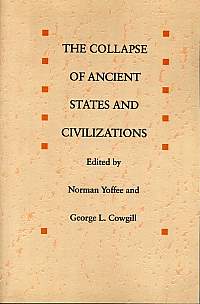
|
The Collapse of
Ancient States
and Civilizations Edited by Norman Yoffee and George L. Cowgill University of Arizona Press 2003 4th printing ISBN# 0-8165-1249-3 paperback How do ancient cultures and societies come to fall apart and eventually collapse, and what is the result of their disintegration? A week long seminar held in 1982 at the School of American Research in Santa Fe was devoted to the subject, leading to this collection of 11 essays by participants who bring to the subject their insights as historians, anthropologists, sociologists, and political scientists. Mesopotamia, the Roman Empire, the Mayan empires, the Han Dynasty and Mesoamerica are considered as specific historic and archaeological examples. There is an introductory look at the classic studies such as Oswald Spengler’s Decline of the West and Arnold Toynbee’s A Study of History, as well as the Club of Rome’s Limits to Growth that considered the possible sources of a modern-day collapse: the potential for a modern disastrous cultural demise lingers in the background throughout many of the essays. Approaches from the viewpoint of general systems analysis, catastrophe theory, political and sociological models are also considered and returned to in later chapters. But the bulk of the book looks at individual cases. Mesopotamia holds interest not only because of an ebb and flow of it’s civilizations over more than a millennia, but also because once it finally fell apart it was nearly completely forgotten until rediscovered by archaeologists in the 19th century. In China the Han dynasty suffered internal divisions between an imperial family and the literati serving in the bureaucracy, with a centralized government less responsive to uprisings in the outer regions becoming unable to resist invasion into those regions. Rome wasn’t built in a day, and it didn’t fall in a day, and the lingering effects of its dissolution are considered, as well as the role of barbarians in societal breakdown. The archaeological evidence in the collapse of two major Mesoamerican societies is dealt with in depth in chapters dealing with Mayan civilization and Teotihuacan. T. Patrick Culbert draws on an earlier School of American Research seminar on the collapse of the Classic Maya phase, as well as research published afterwards, to investigate population densities outstripping increasingly sophisticated agricultural technologies. He draws a conclusion that such “…overextension was ecological and consisted of a population system dependent upon maximal results from a subsistence system that made no allowances for long-term hazards…When expansion reaches the point at which it can no longer produce new wealth, the administrative structures begin to feed off internal resources, a process that cannot long continue without inducing collapse.” Rene Millon draws on decades of work in his chapter on the fall of Teotihuacan, which is worth the price of this volume in itself. At the height of its power in the seventh century it was one of the largest cities in the world, with a population of over 125,000. The importance of Teotihuacan dominated central Mexico, with a religious center dominated by the architectural monuments, including the Pyramid of the Moon and Pyramid of the Moon. Yet around AD 750 this religious center earned the title of the ‘Street of the Dead’ with a selective burning and destruction which affected none of the rest of the city, with similarly selective demolition of temples and palaces throughout the rest of the Teotihuacan valley. This was a blow from which this civilization never recovered, and Millon speculates that an unusually long period of dominance and its “long-term imposition of conformity and resistance to change may have been such that that a process of change that might have transformed the structure of Teotihuacan society assumed an irreversibly destructive course, culminating in the cataclysm that destroyed it forever.” This work offers a wonderful insight
into a
variety of viewpoints on the nature of vanished cultures, and is
available
from the University of Arizona Press in paperback (330 pp) here
for $21.95. reviewed
by
Charles
Swenson
|

|
When is a Kiva?
and Other Questions about Southwestern Archaeology by Watson Smith, edited by Raymond H. Thompson University of Arizona Press 1990 ISBN# 0-8165-1498-4 paperback Watson Smith (1897-1993) left a career as a lawyer to become one of the preeminent archaeologists of the American Southwest. This volume is meant to bring his particularly clear, insightful and witty work out of the dusty pages of little read archaeological journals and make it available to a wider audience. Raymond Thompson had first hand experience in working with Smith since 1948, and in 1990 collaborated with him in selecting the essays for this collection. It captures not only Smith’s pithy style but draws attention as well to many overlooked aspects of Southwestern archaeology. Some of Smith’s most astounding work was on the Hopi kiva known as Room 788 at Awatovi. The kiva was filled with sand before the Spanish built a cathedral over it as an expression of religious superiority. When it was excavated from underneath the cathedral in 1935, it was found that the sand had kept it from collapse, making it one of the most well preserved of all such structures studied. Smith was thrown into the role of working its extraordinarily fine murals, which had been plastered over and repainted in up to a hundred layers in one area. He carefully photographed and accurately drew each layer before carefully removing each layer in a carefully developed technique that transferred the actual painting itself onto a backing for transport to the Peabody Museum. His work established him as an expert in the field of kivas. His continued work with kivas and just exactly what they are led to the essay which lends its name to the book. Its opening paragraph encompasses some of the subtle humor Smith incorporates so readily into his writing. “There are many pitfalls for the unwary Southwesternist, but perhaps the easiest to fall into and most difficult to climb out of is that of the kiva. Almost anyone can stumble into a kiva but unless he is like the Monarch of Mo he cannot usually extricate himself with dignity and grace.” The Monarch of Mo is a reference to an obscure book by L. Frank Baum, author of The Wizard of Oz, and certainly one of the strangest citations ever found in an archaeological paper. His work of necessity extended into ethnography, even utilizing his earlier law degree at one point on a study of Zuni law which has since been used as a reference by the Zuni Tribal Council. He also worked extensively on classification of various motifs in kiva paintings; the depth of this work is exhibited in three separate selections on depictions in murals of feathers, pots and ceremonial bowls, each well enough illustrated to draw in the casual browser. Similar attention to detail is also found in his analysis of painted pottery, a subject in which he excelled in verbally description and classification. He was not the first to use the phrase “psychoceramics” but in his extensive hands-on work with potsherds he came to appreciate that “…both the technological and aesthetic features of an artifact or an assemblage of artifacts may be applied toward an understanding and an interpretation of the mental processes of their makers. Why did certain peoples, or even specific individuals among those peoples, produce ceramic objects with forms and decorative characteristics that distinguish them form the products of other peoples and individuals.” As this collection of his essays
makes abundantly
clear, the world of archaeology is far richer for Watson having made
the
decision to leave the field of law, and, of course, the world at large
is far better off with one less lawyer. This book is a must read for
anyone
interested in Southwestern archaeology, and can be ordered from The
University
of Arizona Press (paperback, 273 pp.) for $20.95 here.
reviewed
by
Charles
Swenson
|
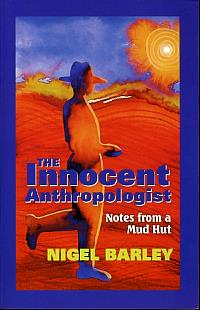
|
The Innocent
Anthropologist by Nigel Barley Waveland Press 2000 reissue ISBN# 1-57766-156-7 paperback There’s something strange about folks who relish time spent in suffering and tribulation, wearing it as a badge of glory, waving it about at parties and in pubs as proof-positive of their total professionalism and experience: They’re the real deal and all others mere posers. That’s what the author encountered whenever he’d run into anyone who had even the slightest bit of anthropology fieldwork experience. He was quite happy being a scholar, a teacher of theory, a researcher poring through others ethnographies: at least he’d thought so. “The whole subject of fieldwork, we effete ‘new anthropologists’ with our doctorates based on library research had decided, had been made rather too much of.” But after an evening of somewhat depressing assessment of the state of anthropology , university life and such, with his friends (“Like Mrs. Hubbard, we had taken stock and found the cupboard was bare.”), the question of going on fieldwork was brought up. “To be fair, there was also the possibility to be considered – slight though it may be – that fieldwork would make some great contribution to human knowledge. On the face of it this seemed rather unlikely. Fact gathering in itself has few charms. Anthropology is not short of facts but simply of anything intelligent to do with them… Frankly, it seemed then, and seems now, that the justification for fieldwork, as for all academic endeavour, lies not in one’s contribution to the collectivity but rather in some selfish development.” What follows, of course, is Barley’s unbelievable nearly year long dash into what seems like utter chaos, a kind of madcap, at times pathetic adventure in northern Cameroon, and out… no small matter as the joke about the toll bridge that’s free to cross over on, but costly to return by here becomes a scary reality. Barley experiences every single nightmare one can imagine from such a trip, or any trip, save being eaten by lions or cannibals. He is even robbed on his way home, in Rome; left destitute in soiled clothing, having to beg cash at the British Embassy. I must say, Nigel Barley is a very entertaining writer. His dry wit and wry style of English humor actually reminds me of Bob Newhart at times... I can almost see Barley, ironically, telling this tale over a couple of pints at the local pub. Despite the tortuous side of the author’s quest to study the Dowayo people, there’s a subtler side to his story and the reader comes away with something more complex than the book’s tone first suggests. The Innocent Anthropologist is hard to put down-- a fantastic read. You even learn something about the mysterious Dowayo people Barley went to study. After reading this totally honest account, you will never think of fieldwork as a romantic adventure, but, then again, some of you just might start packing... Order The
Innocent
Anthropologist direct from the publisher
for
$14.95 by clicking here.
reviewed
by
Bob
Wishoff
|
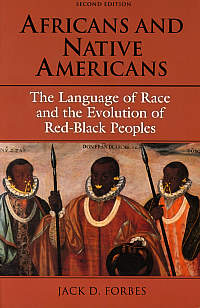
|
Africans and Native
Americans The Language of Race and the Evolution of Red-Black Peoples by Jack D. Forbes University of Illinois Press 1993 2nd ed. ISBN# 0-252-06321-X paperback An unusual book for most readers and somewhat hard to describe, Africans and Native Americans, is a serious discussion of relations between many cultures. It most specificallycovers the relations between Europeans, Americans and Africans that evolved through the despicable trade in human beings which characterized several centuries of European world dominance. As the author writes in his introduction, “Thousands of volumes have been written about the historical relations existing between Europeans and the Native Peoples of the Americas and between the Europeans and Africans, but relations between Native Americans and Africans have been sadly neglected. The entire Afro-Native American cultural exchange and contact experience is a fascinating and significant subject, but one largely obscured by a focus upon European activity and European colonial relations with ‘peripheral’ subject peoples… It is especially important to note here, at the very beginning of this study, that those relations do not begin only in the Americas. On the contrary, they also take place in Europe and in Africa and perhaps also in the Pacific.” Most of the volume focuses on the racial terms used to describe people who were considered slaves. It is very interesting to see where the disparaging terms common (unfortunately) in our current society came from--- you will be surprised to read that the origins of some of the most powerful terms came from descriptions of white Arabs and Jews as well as of black Africans. Basically the terms applied to anyone who could have been called a slave at some time in history. You will also be surprised at the amazingly complex interactions that took place between the various peoples described in the book--- it would seem that no one has really studied the incredible influence slaves from all over the world had on societies within Europe which they were forcibly mixed within. Intermarriages took place at every turn, making defining people by their skin color very difficult, and forcing free people to constantly fear their arrest as runaway slaves. Despite laws that made the taking of slaves from the Americas illegal, describing them as “blacks” enabled them to be sold as having come from Africa, a legal source of human cargo. The entire descriptive system gets bogged down: “Many prominent writes have, it seems, been very lax in their failure to consider that the ‘meaning’ of a word is never a timeless, eternal constant but rather is a constantly evolving changing pointer.” The author shows us this through copious quotes from all sorts of documents which range from seventh century through nineteenth century examples of ship’s logs, slave sales, newspaper notices, dictionaries, letters, memos, laws, etc. In the end, we find that a person’s description, whether as black, mulato, Negro, Moor (many others are listed in the book), are all uncertain terms, changing meanings every ten to fifty years, sometimes even meaning different things contemporaneously across a single region. What seems to be most ironic about the book is its contention that so many people were taken from the Americas, and so many of them interbred (most from marriage, rather than force) with so many other people from across the globe, that by the time slaves were brought to America’s shores, they were in fact “re-peopling” their own land, this time returning with the blood of the world pulsing through their veins. The author contends that the language of racial mixes as well as “mixed-race” people themselves, have affected the history of Europe and America more than has been previously admitted, and that further study is warranted. The evolution of modern racism seems to be partly a history of rhetorical assumptions--- misunderstood terms. The author clearly shows how mixed race people blended into European societies, but segregated into a mind-numbing complex, and imprecise system within the colonies. An interesting read for anyone who
wishes to
know more about the history of race and race relations, as well as for
those who want to know more about the role of slavery in world history.
Africans
and Native Americans can be ordered direct
from the publisher for $21.00 by clicking here.
reviewed
by
Bob
Wishoff
|

|
Edward Sheriff
Curtis: Visions
of a Vanishing Race by Florence Curtis Graybill and Victor Boesen Introduction by Harold Curtis The University of New Mexico Press 2000 ISBN # 0-8263-2249-2 paperback It is sometimes hard to tell whether this is a biographical account of Edward Sheriff Curtis, one of the most prolific students of American Indians at the beginning of the twentieth century, or a biography of his amazing twenty volume work, The North American Indian. Ultimately the two are so intertwined that this book, written in part by Curtis’s daughter in 1976 is as much about the 25 year struggle for publication of this classic tome as it about her father, a man she rarely saw. The very title of this sumptuously illustrated edition of her book, Visions of a Vanishing Race, gives voice to his greatest legacy, thousands of photographs of a people that seemed destined to disappear from the face of the earth. Curtis was running a photography studio in Seattle in the 1890s when he first began to take photographs of local costal Indians, one of which won grand prize at the National Photographic Exhibition and was exhibited around the world. His interest in documenting Indians culture grew during a visit to a Blackfoot encampment of over 1000 teepees in Montana where he witnessed the Sundance. This led to a growing realization of the need for collecting information on these tribes before it was lost for all time. As he later wrote, “The great changes in practically every phase of the Indian’s life that have taken place, especially within recent years, have been such that had the time for collecting much of the material both descriptive and illustrative…been lost, it would have been lost forever. The passing of every old man or woman means the passing of some tradition, some knowledge of sacred rites possessed by no other; consequently the information that is to be gathered, for the benefit of future generations, respecting the mode of life on one of the great races of mankind, must be collected at once or the opportunity will be lost for all time.” His exhibitions captured the attention of Theodore Roosevelt, who wrote him a glowing testimonial to help him further his efforts. This letter helped arrange a 1906 appointment for him with J. P. Morgan, who characteristically refused any assistance initially. But after viewing his work, Morgan told him “Mr. Curtis, I want to see these photographs in books---the most beautiful set of books ever published.” With regards to the writing, Morgan insisted to “You are the one to write the text. You know the Indians and how they live and what they are thinking.” The writing, edited by Frederick Webb Hodge, was to cover vocabulary, music, spiritual beliefs, homelife, history, mythology, folktales and other areas of interest on 84 different tribes, with all research done while living in the field with the tribes. This was the beginning of The North American Indians, planned to be sold by subscription in a limited edition of 500, with each of the twenty morocco leather volumes of 300 pages of text and 75 photogravures, accompanied by a larger portfolio volume of at least 36 photogravures. This was an effort that was to take the next 24 years and $1,500,000 to complete. Sales were slow, in no small part due to its price of $3,000, (in time rising to $4,500) and finding buyers, making publishing deadlines and seeking favorable reviews (Curtis had no academic background) was a constant struggle. Shortly after the final volume was finished The North American Indian Company, which had been formed to handle the book’s financing, went bankrupt, with the unsold copies and original copper printing plates being sold to satisfy creditors. The photogravure plates were eventually rediscovered in the basement of the Lauriant Bookshop, and the value of Curtis’s work was once again realized in the public’s mind, and The Curtis Collection purchased the plates. A visit to their website offers some interesting insights on the nature of these photogravure plates produced from his photographs, which in actuality produce unique prints with each run, accounting for some of the slight differences in each print a careful eye can discern. It was about this time that the text of the book being reviewed was written by his daughter. Curtis was the sort of man an avid outdoorsman such as Teddy Roosevelt admired, and Florence Curtis Graybill has lavished her book with numerous examples of his adventures. Although his family was present on very few of his outings, she has put together a fascinating picture of his adventures in the course of his research. We find him escaping from hostile Navajos in Canyon de Chelly, visiting Little Bighorn with Indian veterans from both sides of the battle, scavenging graveyards at midnight for mummies and skulls for a whale hunt, breaking his hip in one close encounter with a whale, wrestling with an octopus on the Pacific coast and battling winter storms on the Bering sea in a forty-foot boat. He was also probably the only white man to be allowed to be initiated by the Hopi as a priest in the Snake Order, participating in their lengthy rain making Snake Dance ceremony. (“Being a priest in these ceremonies is not an unmixed delight. I remember once in the Navajo desert of Arizona when I had participated in a nine-day ceremony---day and night, you understand, for nine days---and when I left them at dawn on the last day if any one had tried to pick up my trail he would have found it forty feet wide, though I was trying to walk a straight line. Dancing, fasting, and all the rest of it, it was not easy.”) Curtis has probably done more than any other individual to make the life of the American Indian as accessible to us a century later, and for this we have much to be grateful for. As Teddy Roosevelt wrote in his foreword to The North American Indian, “…It would be a veritable calamity if a vivid and truthful record of these conditions were not kept.. Mr. Curtis, because of the singular combination of qualities with which he has been blest, and because of his extraordinary success in making and using his opportunities, has been able to do what no other man ever has done’ what, as far as we can see, no other man could do…He has lived on intimate terms with many different tribes of the mountains and the plains. He knows them as they hunt, as they travel, as they go about their various avocations on the march and in the camp. He knows their medicine men and sorcerers, their chiefs and warriors, their young men and maidens. He has not only seen their vigorous outward existence, but has caught glimpses, such as few white men ever catch, into that strange spiritual and mental life of theirs’ from whose innermost recesses all white men are forever barred.” We should be thankful now that we also have the work of his daughter to make the life of this remarkable man come alive for us as well. Edward Sheriff Curtis: Visions of a Vanishing Race, is a wonderful introduction to not only the man but his work as well. The text throughout is illustrated not only with some of his more memorable works, many of which readers unfamiliar with Curtis will nonetheless recognize. This is followed by 95 full page duotone reproductions of his photographs in sepia as well, capturing the feel of these portfolio photogravures. (I’m seriously considering framing some of them.) This 9”x12” paperback is available from the University of New Mexico Press, by clicking here, for the price of only $29.95, and is the sort of book that is not only of great interest to anyone with an interest in American Indians, but would make a great gift book as well. Unfortunately, The North American
Indian is
not in print, although few personal libraries would be able to
accommodate
the five feet of shelf space the original required. It’s also
doubtful
that you’ll come across any used copies, since just the first volume of
the twenty was commanding a price of $22,500.00 several years
ago.
But it is possible to peruse the complete contents of all twenty
volumes
(copy #458 of the original 500, including the portfolios, courtesy of
Northwestern
University’s Digital Library collections, by visiting their website.
This
is a real treat, and well worthy of a visit. Numerous other
sites have the photographs available, but one of the more interesting
is
the Wikipedia
page, which has a link to a copy of a microfiched 1911 New York
Times
article with an interview of Curtis during a lecture tour promoting The
North American Indian. reviewed
by
Charles
Swenson
|
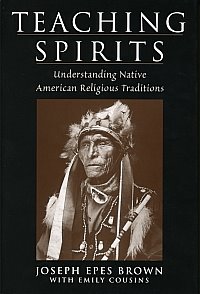
|
Teaching Spirits
Understanding Native American Religious Traditions By Joseph Epes Brown, with Emily Cousins Oxford University Press 2001 7th printing ISBN# 0-19-513875-9 cloth hardback In Native American culture, sacred presence permeates everything. With no word for “religion” in their language, Native Americans do not separate their beliefs from their everyday lives. Native people live in the present and their languages also express this as well; there is frequently no past or future tense. The non-Native world is a world of straight lines and linear thinking, while Native ways express the cyclical nature of life and time. What all of this means is that non-Native and Native worlds were perhaps destined to clash as there are basic differences in the way they look at the life day-to-day. Native peoples living in the modern world have frequently forsaken their ways, and non-Natives, sometimes feeling adrift in the modern world and isolated from their own belief systems, try to turn to Native religions. Joseph Brown, seeing an opportunity, created a series of lectures on the topic, all of which, lovingly transcribed by Emily Cousins, will both inform the reader and enchant at the same time. What Brown is so good at is taking a complex topic like Native American spiritual thought and showing us all the common threads that run throughout. His lectures offer something for everyone. For the Native American, this book underscores how spiritual life, the life of the “now,” is ever-present fact. For the non-Native, this book emphasizes the flaws of picking and choosing from a spiritual tradition--- non-Natives just simply do not understand the complex under-currents that drive Native spirituality. Yet here there is yet something for everyone—Native American religious traditions can teach us all to become better humans, and to live our lives more fully. “Once non-Natives come to see what an authentic religious tradition is, they can revitalize those same components in their own traditions. The model provided by Native American traditions can help people recover some of the unraveled threads fo their proper history, heritage, and sacred realities. With the few selected examples I offer in my work, I aspire to give a brief sampling of some of the core Native American values and perspectives. Through these, non-Natives can perhaps come to relearn a little bit about themselves and about their own proper spiritual heritage, with the hope that what has been lost can still be rediscovered. Certainly, the Native American people themselves, especially the younger ones today, are trying to regain and revitalize their own traditions that may have been lost of taken from them through a variety of pressures and prejudices. Non-Natives have in this struggle, I suggest, a model for their own proper quests.” Teaching Spirits,
is a unique book, in my opinion, and should be read by anyone with an
interest
in Native American tradition. It can be ordered directly from the
publisher,
for $35.00, by clicking here.
reviewed
by
Bob
Wishoff
|
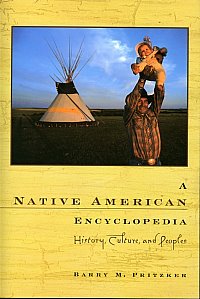
|
A Native American
Encyclopedia History, Culture, and Peoples By Barry M. Pritzker Oxford University Press 2000 4th printing ISBN#0-19-513877-5 paperback For anyone interested in Native American culture, A Native American Encyclopedia contains everything you ever wanted to know about every Native group extant in the United States. Barry Pritzker has done an incredible job at pulling together a wealth of diverse information into this book, writing in his introduction that “It is not too late to learn from Native Americans. In light of past and ongoing injustices and the momentum of Indian and Inuit self-determination movements, I would say that an understanding of Indian and Inuit cultures and concerns is essential. The past cannot be changed, but we can recognize aspects of history commonly deemed unimportant, such as the dynamics of native cultures as well as the vital contributions of Native Americans to contemporary society.” The book is organized into ten geographical sections: The Southwest, California, The Northwest Coast, The Great Basin, The Plateau, The Great Plains, The Southeast, The Northeast Woodlands, The Subarctic, and The Arctic. Each alphabetic entry outlines Native group history, location, population, customs, dress, diet, key technology, notable arts, transportation, war and weapons. There is also a section for each group which outlines contemporary information such as government/reservations, economy, legal status, and daily life. The book also contains a pronunciation guide (you will be most grateful for this!), maps, index, glossary, bibliographies, and numerous illustrations and photographs. One of the first things which will strike you about the book is the number of Native American groups (I’m not using tribes, because, as the author points out, many groups did not consider themselves “of a tribe,” but as a group of allied families, for example) exist that you might not have heard of before. This book makes it very clear that Native America is alive, if not ailing, and that Native culture is rich and diverse. On the other hand, you might be shocked to see how many groups have under a dozen living members. This book is written in a
surprisingly engaging
style and I found myself perusing the contents for 2 hours on my first
browse! Whether used for a quick reference needed for a paper you might
be writing, or just for a pleasant and informative read that will last
you a month or two, you’ll absolutely enjoy this well executed
encyclopedia.
A great value at $29.95 (the book is out of stock in hardback), order
it
up direct from the publisher by clicking here.
While
there, be sure to look over the rest of Oxford University Press
titles!
Being the world’s largest university press, I’ll bet you’ll find more
great
books to buy! reviewed
by
Bob
Wishoff
|
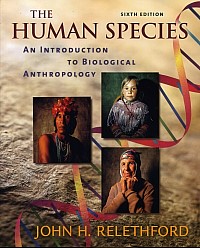 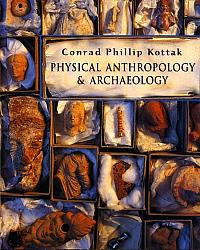 |
The Human Species
Here are two of the most popular textbooks for Introduction to Physical Anthropology courses (also called a core course.) Each of them takes a slightly different perspective toward the discipline.
This is a rigorous coursework! The student should be prepared to do a great deal of studying of lots of detail. The book contains copious illustrations, maps, photographs and drawings. There are also a lot of review sections for students to become reacquainted with concepts they may have learned in high school but since forgotten. Each section ends with suggested readings both online and in other printed publications. The book also contains a glossary, an appendix which explores statistics and the human skeletal system, and an extensive reference section. As with most of the excellent textbooks published by McGraw-Hill, there is an online component called the Human Species Learning Center, a formerly optional extra not included outside of a “purchased bundle” but now free of charge. The Learning Center is a very useful tool and comes complete with course outlines, flash cards, and sample tests. Kottak’s text looks at biological diversity and evolution, but takes a more cultural and archaeological view toward application of this knowledge. There is more emphasis on archaeological evidences and excavations work, and more details about early hominids. There is much less information about genetics and other primates, especially biological data. Much more time is spent looking at different cultures of the world and seeing the influence of these cultures on the biology around them. For example, there is more emphasis on the evolution of civilization, how this has affected the environment, and how this accumulation of changes has affected human life. Kottak’s text is also lavishly illustrated, and each section ends with critical thinking questions, suggested additional readings, and online exercises. There is also a glossary and bibliography at the book’s end. Also similar to the Relethford text, there is an online component, also free-of-charge, which offers the student many extra resources for studying the text. Which text to use is a matter of which perspective the teacher wishes to most emphasize as part of his or her curriculum. Both books are excellently written, and are but two of fourteen Physical Anthropology core texts offered by McGraw-Hill Higher Education. Qualified instructors may request a free copy of any textbook for evaluation purposes. Home-schoolers should contact the publisher for pricing information. Click here to see the entire selection of Physical
Anthropology texts offered by McGraw-Hill Higher Education. reviewed
by
Bob
Wishoff
|
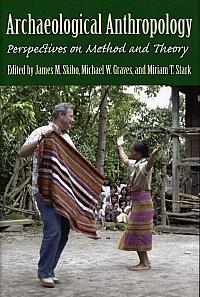 |
Archaeological Anthropology: Edited by
James M. Skibo, Michael W. Graves & Miriam T.
Stark It could be argued that the “New Archaeology,” or processual archaeology movement of the 1960’s, led by Lewis R. Binford, and carried on by William Longacre and others, was perhaps the single most important theorectical revolution in the history of modern anthropology. This revolution demanded an explanation for things and those who practiced it had no time for mere description of behaviors and artifacts, as they claimed others had been doing for years. Indeed, there is a great deal of published materials
which
both laud and deride the processualists—this book, however, is meant to
show
how students have built upon and revised the work of William Longacre.
Longacre studied pueblo villages in the American Southwest
and hypothesized that you could tell matrilocality (whether women
resided with
their families or their husband's families after marriage) from the
spatial
distribution of potsherd decorative styles within a settlement. (See
our review
of his still in-print, must-read paper here).
His
explanations, while controversial, remain today as
models of the processual paradigm. In this book, contributors “focus on
six themes prominent in Longacre’s career: the intellectual history of
the
field in the late twentieth century, archaeological methodology,
analogical
inference, ethnoarchaeology, cultural evolution, and the reconstruction
of
ancient society.” Archaeological
Anthropology is
chock-full of theory— twelve chapters such as “Archaeological
Anthropology and
Strategies of Knowledge Formation in American Archaeology”
and “Contingency Theory and Pottery
Production” might sound a little too abstract for the casual reader,
but prove
to be quite interesting and within reach when carefully read. reviewed
by
Bob
Wishoff
|
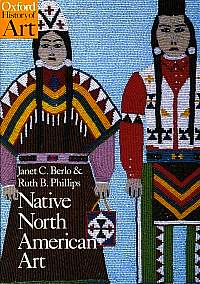 |
Oxford
History of Art:
Part of the Oxford History of Art series, Native North American Art is meant to be a textbook, and while it would indeed make a fine coursework, it is also a great read for anyone who would like to pass beyond being merely an observer of pretty things. There is a living culture in this art, and this book quickly points out how long it took Europeans to understand the deeper meaning in the art they’d collected from the frontier. There also is a tendency to forget that Native Americans still create vital new art in all media—that there are cultural artistic themes which span across time. The book not only attempts to answer basic questions such as “What is Art?”, but also takes on “What’s an Indian?” Native American cosmology is also explored as it is an important recurring theme. Art’s role in public display, the power of adornment, as well as gender in the creation of art and creativity’s role in culture are all explained before the reader is focused upon specific traditions. The meatiest part of the book discusses artistic traditions and styles by region. Each region’s section is lavishly illustrated, the text clearly demonstrating the importance of art within specific communities. The arrival of Europeans, and their effect upon those traditions are also examined. The reader quickly sees how the dynamic of the communities changed as reflected in art motifs. The final chapter introduces the reader to twentieth century trends in Native Art—remember, these are living cultures. This book will be of interest to readers at all levels. The “collector” of Native American art will benefit by learning of the deep meaning of their acquisitions. The student of Native American traditions will find the book a rich source of information useful in any number of serious anthropological and archaeological inquiries. The book has 40+ pages of notes, charts and references. This 350 page book is very reasonably priced. Printed on slick paper and well-bound, it sells for only $23.50, and can be ordered direct from the publisher by clicking here. reviewed
by
Bob
Wishoff
|
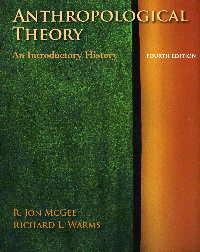 |
Anthropological
Theory:
The book is in its 4th edition, but strangely, McGraw-Hill’s website does not yet list it, but instead promotes the 3rd edition (the Table of Contents, etc.)… not to worry as the book’s official publication date is 2008 and will likely list after the New Year. I’m sure an email to the sales department will get you a copy of the latest edition. Textbooks aren’t inexpensive (as any student knows), and this one retails for $87.81, but you’ll likely keep it, and reference it many times. Don't forget to read the footnotes! Get Anthropological Theory: An Introductory History at the McGraw-Hill Higher Education website—click here. reviewed
by
Bob
Wishoff
|
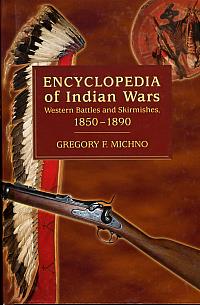 |
Encyclopedia of Indian Wars Western Battles and Skirmishes 1850-1890 By Gregory F. Michno Mountain Press Publishing Co. 2nd printing 2005 ISBN#0-87842-468-7
hardback An exerpt
from 18
March 1856, Pistol River, Oregon will give you an idea of why the book
is so compelling: "... Suddenly many more warriors appeared. Abbot was
in trouble. He fell back to the seashore, prepared a barricade from
driftwood, and sent a messenger back to Buchannan. Soon the
Rogues
surrounded the volunteers and peppered them with bullets."
Ouch! ... just another day in the wild, wild west, a concept that,
later in the book, author Gregory Michno ascribes to as no myth and
very real indeed. By the time you get to that point, and have read
these accounts, you might be more amenable toward the idea. Michno
writes
that he put the book together to aleviate what he considered to be a
shortage of books on Indian battles that "are sufficiently
comprehensive, detailed or accurate for my satisfaction... Hundreds
more conflicts took place than those cited... but information about
them is so scarce and hard to find that the research hits a point of
diminishing returns. Though not complete, this survey offers enough
information to be a useful resource and a sampling sufficient to draw
conclusions." And Michno
offers some conclusions of his own, which he
says were drawn from his own study of 1,470 fights. Basically, the
image everyone grew up with of "The Wild West," was real. Of
course, these
battle records are all from non-Indian points of view. But the
book's not really about a point of view, but about patterns of
reporting, especially of losses of life. Michno discusses this and more
within
his conclusions. This 400+
page
reference is well-organized, with maps of each state showing locations
of reported battles, and lots of other photos and illustrations.
The
Appendix is supplied with a fine bibliography for those who wish to
further pursue research in the topic. Encyclopedia of Indian Wars is a modestly priced hardback at
$28.00 and can be ordered directly from the publishers by clicking here. reviewed
by
Bob
Wishoff
|
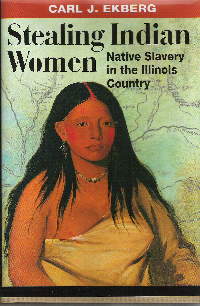 |
Stealing IndianWomen: The subject of Indian slavery, both inter-tribal and in-league with and enslavement-of European settlers, is a topic of growing interest to historians, anthropologists and archaeologists. Its significance in early colonial America achieved prominence with Alan Gallay’s Bancroft Prize winning study of the traffic in tribal captives, The Indian Slave Trade: The Rise of the English Empire in the American South, 1670-1717. Carl Ekberg, professor emeritus of history at Illinois State University, has now made another important contribution to our understanding of this little understood phenomenon among French colonies in the Mississippi Valley in the mid-17th century. It is a two part book, and “Part 1 of this work provides an account of Indian slavery in Upper Louisiana during the 100 years between the late seventeenth and late eighteenth centuries…during that time period that the pernicious institution of Indian slavery became organically implanted in the villages of the Illinois Country…” Ekberg starts with a broader scope encompassing the entire French experience with Indian slavery along the Mississippi, as well as the transitions that followed Spanish acquisition after the Treaty of Fontainebleau and resultant English control of the eastern shores following the French and Indian Wars. His focus then narrows to the remarkably complete county clerk records of Ste. Genevieve in what is now Missouri. Census reports and parish records paint a clearer picture of an indentured population that accounted for about 40% of the total number of souls, with roughly 40% of those slaves in turn being Indian. Although throughout much of the period covered by Ekberg’s account slavery was technically illegal and such trade had been banned by both the French and Spanish governments, the local officials themselves were often the greatest slaveholders. The scope of the last half of this book results from a remarkable set of civil records and which “dovetail to describe in extraordinary detail a fascinating story involving Indian slavery, miscegenation, grand larceny, kidnapping, and possible murder. Investigations pertaining to this complex case provide information to fashion a rich portrait of colonial society in the Mississippi River valley. When teased out of the manuscripts, this portrait casts into high relief important aspects of that society: slavery, race and gender relations, Creole culture in the Mississippi Valley, French and Spanish colonial laws and even vernacular architecture. No other documents from that time and place transport us, as these do, into the very minds and habits of Indian slave women, Spanish administrators, French -Creole habitants, and metis coureurs de boise.” Here the book tightens to the account of Celadon and Marianne, two Indian slaves who escaped to live a life in the wilds. Since this episode also involved a murder (or accidental death?), and the first episode of a formal investigation into a capital crime in the region, the records are extensive. Ekberg does a masterful job of extracting from them a lively and enjoyable exposition on the particulars of how the Indian slave trade manifested itself in within the community. This nicely balances the more demographic first half while still guiding the alert reader through the process of how those demographics can be made to reveal the details of how deeply entrenched the Indian slave trade. Stealing Indian Women (240 pages, illustrated, cloth-bound, $38.00) is available directly from the University of Illinois Press website for the book: click here to go directly to this book's webpage. reviewed by Charles
Swenson
|
 |
Sacred Realms Essays in Religion, Belief and Society edited by Richard Warms, James Garber, and Jon McGee Oxford University Press 2004 ISBN# 0-19-517550-6 oversized paperback
reviewed
by
Bob
Wishoff
|
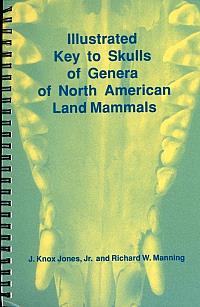 |
Illustrated Key to Skulls of Genera
of North American Land Mammals By J. Knox Jones, Jr. and Richard W. Manning Texas Tech University Press 1992 7th Edition ISBN 978-0-89672-289-9 spiralbound paperback Finally, an illustrated key to mammal skulls! Those of us who haunt the outdoors surveying for archaeological sites, or who find skulls as part of an excavation, but who are not biologists, can have a hard time trying to identify what we stumble upon. This little 80 page book will make things easier for all of us. One small problem with the book, however, is that it fails to show mandibles for most of the skulls, and this can make identifying animals by skull parts a bit trickier than it should be. But all-in-all, you'll appreciate this book everytime you pick it up. At only $12.95, the Key is a real bargain. Order it direct from the publisher by clicking here. reviewed
by
Bob
Wishoff
|
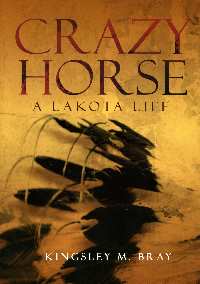 |
Crazy Horse A Lakota Life By Kingsley M. Bray University of Oklahoma Press 2008 1st paperback ed. ISBN# 978-0-8061-3986-9 Up
until now, scholars interested in the life of Crazy Horse, arguably on
of the
most famous Lakota Sioux chiefs, were limited to Mari Sandoz’ Crazy Horse, the Strange Man of the Oglalas.
While Sandoz’ book is a compelling read, it contains many
reconstructions and
imputations of Crazy Horse’s motivations which lie squarely within the
domain
of fiction. Historical events are taken out of sequence in order to
maintain
dramatic effect, and the darker sides of characters are emphasized and
made
over important. As Bray puts it, “Crazy
Horse, the Strange Man of the Oglalas remains a literary tour de
force, but
no one today would attempt to reconstruct the reign of Henry V by
reading
Shakespeare.” What
Bray has written is an outstanding biography that scholars and
interested
readers alike will find a fascinating and enjoyable read. In addition,
the
nearly 100 page notes and bibliography sections provide a basis for
more
exploration of the life of this enigmatic Lakota leader. Bray’s book
quite
simply sets the bar for any and all other historians engaged in writing
biographical works. This book has already received its share of awards,
most
notably, the Best Book of 2006 by the Custer Battlefield Historian and
Museum
Association, and a Spur Award for Best Western Biography from the
Western
Writers of America. reviewed
by
Bob
Wishoff
|
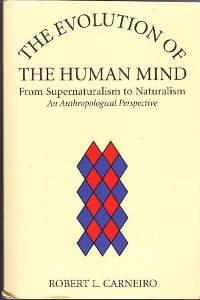 |
The
Evolution of the Human Mind:
This book is a fine example of how pure anthropology can not only be relevant but powerful! What Carneiro does within this volume is to point out where anthropology makes a difference-- about where it can transcend politics and political correctness. Only an anthropologist can, according to Carneiro, rationally summarize the evolution of the human mind and its perspective toward reality. To an anthropologist, the “truth” of soul and spirit is not as interesting, perhaps, as are the interesting logical dilemmas that thinkers and scientists bumped up against as humans discovered the natural world around them, and observed certain “universal” natural laws that would seem to negate commonly held spiritual “truths” about how such things worked. Carneiro
notes
that no chimpanzee believes in God, and no other animal seems to be
concerned with that which does not seem to exist. Only humans concern
themselves with “supernatural conceptions.” Only human beings think
religiously. Why is this so? Why do we need to know why things are what
they
are? The story that unfolds of how we know what we know is a
surprisingly good
read! Even better are all of the perambulations and rationalizations
that intellects used to keep God shoehorned into our concepts of
reality. The Evolution of the Human Mind takes us through the thought processes we have used to make sense of the world. What was the impact of the notion of cause and effect, and of the discovery of “natural laws”? How did our notion of “deity” change over time? As we came to understand what makes life “tick,” how did our acceptance of “miracles,” and “afterlife,” shift intellectually? The author cites all of the great philosophers, scientists and theologians to illustrate the shifting of our notions of reality. Perhaps that is putting it too kindly. Many people lost their lives, or their professions, solely based on those notions. The author writes that, “Supernaturalism was once humanity’s best—indeed virtually its only —way to explain what it experienced and could not readily comprehend. During the last few centuries, this view has yielded (if only grudgingly) to a robust and expanding philosophy of naturalism.” But without anthropology to truly study and explain religion, Carneiro believes that relevant arguments devolve into a meaningless Science vs. Religion debate. Carneiro argues that only the anthropologist focuses on the history of the development of theology, and that the anthropological study of religion “tells us immeasurably more about the origin, nature, attributes, and evolution of god than do the most powerful and penetrating instruments of the physical or biological sciences… It also tells us about the specific circumstances that gave rise to particular elements of religious belief… One can even say that supernaturalism is the warp through which run the weft threads of social life.” The Evolution of the Human Mind is a skillfully written book that you won’t regret buying. It is destined to be a classic. Carneiro makes direct statements that writers love to cite (and readers love to read). His publisher, Eliot Werner Publications, Inc., is proving to be one of the most interesting small presses to come around in awhile-- spend some time looking over what they have on offer! Order a copy of Dr. Carneiro's book ($39.95, paperback) direct from the publisher, by clicking here. |
| Home | Gallery | Latest Finds | Back to Main Book Review Index |